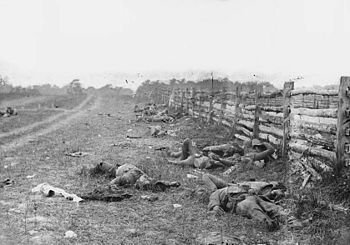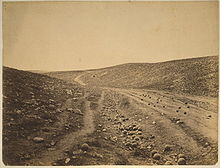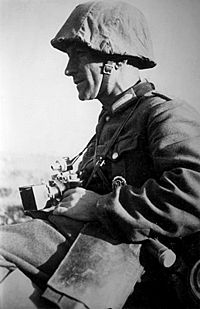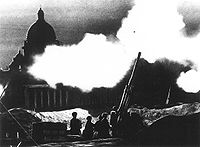- War photography
-
"War photographer" redirects here. For the 2001 documentary, see War Photographer.
War photography captures photographs of armed conflict and life in war-torn areas.
Although photographs can provide a more direct representation than paintings or drawings, they are sometimes manipulated, creating an image that is not objectively journalistic.
Contents
History
Photography, presented to the public in 1839, was believed to create images that were accurate representations of the world. Photography was used to record historical information, but not always in the optimistic way that was conceived at the advent of the medium.
It was anticipated that photographers, supposedly not acting as active participants of war but as neutral partisan, would be able to bring their cumbersome photographic equipment into the battlefield and record the rapid action of combat. This was not the case, as the technical insufficiency of the photograph in recording movement was not considered. The daguerreotype, an early form of photography that generated a single image using a silver-coated copper plate, took a very long time to produce. This prevented action photography, as images took minutes to develop and could not be processed immediately.
The first war photographer was an anonymous American who took a number of daguerrotypes during the Mexican–American War, in 1847, of the occupation of Saltillo.[1] The first known war photographer is the Hungarian-Romanian Carol Popp de Szathmàri who took photos of various officers in 1853 and of war scenes near Olteniţa and Silistra in 1854, during the Crimean War. He created some 200 pictures albums, which he personally offered in 1855 to Napoleon III of France and Queen Victoria of the United Kingdom. About 9 of his pictures survive today[2] The French photographer Ernest Edouard de Caranza caught his countrymen in their camp near Varna, in 1854. He was followed by Roger Fenton, in 1855, although with his bulky equipment he was limited to posed still photographs or landscapes. He took a large van and an assistant, and returned to Britain with over 350 usable large format negatives.
In the late 1850s, Felice Beato traveled to India to photograph scenes from the recent mutiny, and produced a number of images of the Siege of Lucknow and the Siege of Delhi. Shortly thereafter, he went to China to record the aftermath of the Second Opium War.
The inability of the early photograph to record a moving object lead to the practice of recreating scenes of battle, such as in the work of both Haley Sims and Alexander Gardner. They admittedly reconfigured scenes that took place during the American Civil War (1861–65) in order to intensify the visual and emotional effects of battle.[3] Alexander Gardner and Mathew Brady rearranged bodies of dead soldiers during the Civil War in order to create a clear picture of the atrocities associated with battle. In Soldiers on the Battlefield, 1862, Brady produced a controversial tableau of the dead within a desolate landscape. This work, along with Alexander Gardner’s 1863 work Home of a Rebel Sharpshooter[4] were images, which, when shown to the public, brought home the horrific reality of war.[5]
 American Civil War photographer Samuel Cooley pictured standing behind camera in the distance, parapet, Fort Sumter, South Carolina, 1865.
American Civil War photographer Samuel Cooley pictured standing behind camera in the distance, parapet, Fort Sumter, South Carolina, 1865.
The Second Anglo-Afghan War of 1878–80 was photographed by John Burke who traveled with the Anglo-British forces. This was a commercial venture with the hope of selling albums of war photographs.
Since early photographers were not able to create images of moving targets, they would record more sedentary aspects of war, such as fortifications, soldiers, and land before and after battle along with the re-creation of action scenes. Similar to battle photography, portrait images of soldiers were also often staged. In order to produce a photograph, the subject had to be perfectly still for a matter of minutes, so they were posed to be comfortable and minimize movement.
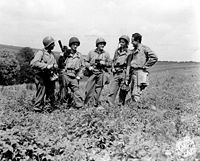 War photographers during the Battle of Normandy.
War photographers during the Battle of Normandy.
In the 20th century, photographers covered all the major conflicts, and many were killed as a consequence. One of the most famous was Robert Capa who covered the Spanish Civil War, the D-Day landings and the fall of Paris, and conflicts in the 1950s until his death by a landmine in Indochina in May 1954. The famous photograph of the flag-raising on Mount Suribachi on Iwo Jima in 1945 was taken by photojournalist, Joe Rosenthal. Photojournalists continue to cover conflicts around the world.
Unlike paintings, which presented a single illustration of a specific event, photography offered the opportunity for an extensive amount of images to enter circulation. The proliferation of the photographic images allowed the public to be well informed in the discourses of war. The advent of mass-reproduced images of war were not only used to inform the public but they served as imprints of the time and as historical recordings.[6] Mass-produced images did have consequences. Besides informing the public, the glut of images in distribution over-saturated the market, allowing viewers to develop the ability to disregard the immediate value and historical importance of certain photographs.[3]
War photographers
Photographers who participate in this genre may find themselves placed in harm's way, and are sometimes killed trying to get their pictures out of the war arena. Journalists and photographers are protected by international conventions of armed warfare, but history shows that they are often considered targets by warring groups — sometimes to show hatred of their opponents and other times to prevent the facts shown in the photographs from being known. War photography has become more dangerous with the terrorist style of armed conflict as some terrorists target journalists and photographers.[citation needed] In the current Iraq War, several photographers have been captured and executed by terrorists or shot in the knee cap by armed insurgents.[citation needed] Several have also been killed by US fire; two Iraqi journalists working for Reuters were notably strafed by a helicopter during the July 12, 2007 Baghdad airstrike, yielding a scandal when Wikileaks published the video of the gun camera.
War photographers need not necessarily work near active fighting; instead they may document the aftermath of conflict. The German photographer Frauke Eigen created a photographic exhibition about war crimes in Kosovo which focussed on the clothing and belongings of the victims of ethnic cleansing, rather than on their corpses.[7] Eigen's photographs were taken during the exhumation of mass graves, and were later used as evidence by the War Crimes Tribunal in The Hague.[8]
Iconic images
See also
See also Category: War photographers.- Embedded journalism and War correspondent
- Damien Parer, Kokoda Track, Kokoda Front Line!
- Photographers of the American Civil War
- Photojournalism
- War artist
- Works
References
- ^ Daguerrotypes of the Mexican-American War
- ^ Carol Popp de Szathmàri's 1854 war photos: http://archweb.cimec.ro/scripts/PCN/Clasate/detaliu.asp?k=0F09ED4E21424AA580A2C07E81236E42 - http://archweb.cimec.ro/scripts/PCN/Clasate/detaliu.asp?k=60BD72B84B1846309395BB55F437C925
- ^ a b Marien, Mary Warner, Photography: A Cultural History second edition (NJ: Pearson Prentice Hall, 2006), pp. 99, 111.
- ^ Alexander Gardner. Home of a Rebel Sharpshooter, MoMA.org, Gettysburg from Gardner's Photographic Sketchbook of the War, (1865). July 1863, http://moma.org/collection/browse_results.php?criteria=O%3AAD%3AE%3A2079&page_number=1&template_id=1&sort_order=1
- ^ Stokstad, Marylyn, Art History vol 2 revised 2nd edition (NJ: Pearson Prentice Hall, 2005), 1009.
- ^ Kriebel, Sabine, “Theories of Photography: A Short History,” in James Elkins, ed., Photographic Theory (New York and London: Routledge, 2007), pp. 7, 8.
- ^ "Fundstücke (Found Objects), Kosovo 2000". National Gallery of Canada. http://www.gallery.ca/en/see/collections/artwork.php?mkey=99832.
- ^ "Exceptional Young Photographer – Frauke Eigen at the Berlin Gallery "Camera Work"". Deutsche Welle. http://www.dw-world.de/dw/article/0,,495139,00.html.
Further reading
- Capa, Robert (1999). Heart of Spain: Robert Capa's photographs of the Spanish Civil War: from the collection of the Museo Nacional Centro de Arte Reina Sofía. [Denville, N.J.]: Aperture Foundation, Inc. ISBN 0893818313
- Harris, David (1999). Of battle and beauty: Felice Beato's photographs of China. Santa Barbara, CA: Santa Barbara Museum of Art. ISBN 0899511015
- Hodgson, Pat (1974). Early war photographs. Reading: Osprey Publishing. ISBN 085045221X
- Katz, D. Mark (1991). Witness to an era: the life and photographs of Alexander Gardner: the Civil War, Lincoln, and the West. New York, N.Y.: Viking. ISBN 0670828203
- James, Lawrence (1981). Crimea 1854-56: the war with Russia from contemporary photographs. New York: Van Nostrand Reinhold. ISBN 0442245696
- Lewinski, Jorge (1978). The camera at war: a history of war photography from 1848 to the present day. London: W. H. Allen. ISBN 0491024851
External links
- PBS on war photography
- War Photographer (Documentary)
- At War: Photographers' Best Shots - slideshow by Life magazine
- Anne S. K. Brown Military Collection, Brown University Library Includes war photographs by Roger Fenton, Felice Beato, Alexander Gardner, Matthew brady and others.
- An Eyemo camera used in 1942 by Damien Parer filming the Academy Award-winning documentary, Kokoda Front Line!, in New Guinea is held at National Museum Australia Canberra
Categories:- Photography by genre
- War photography
Wikimedia Foundation. 2010.

